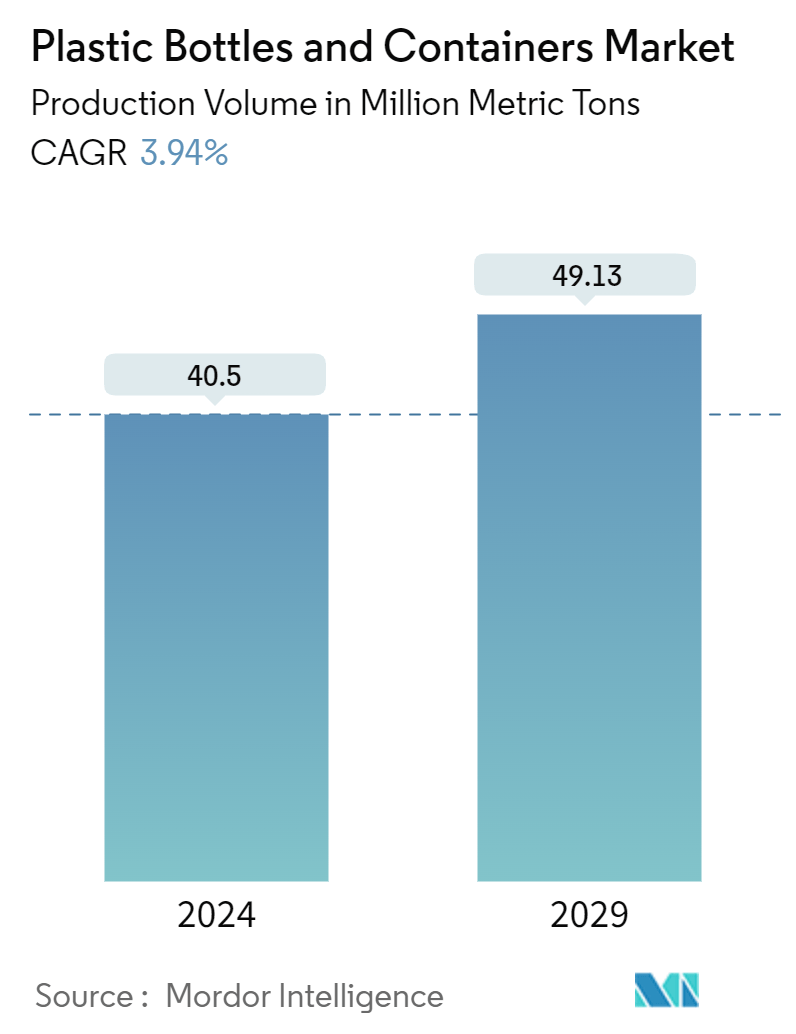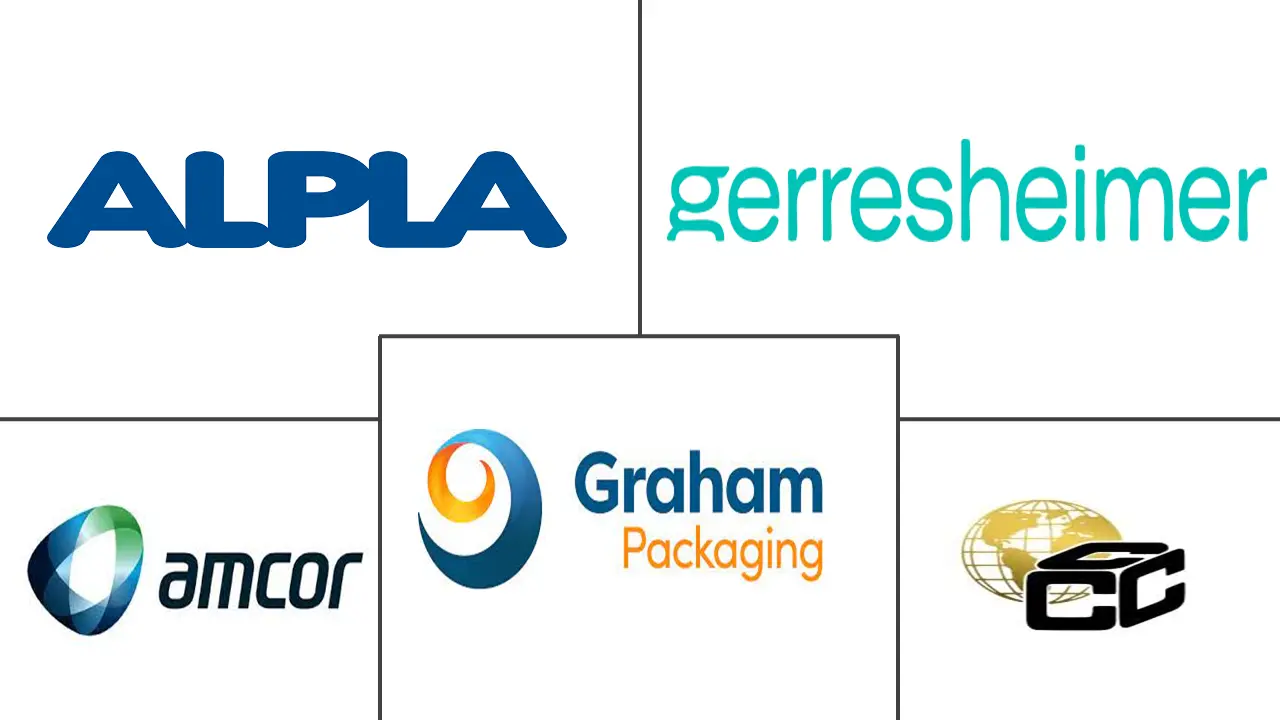Market Size of Plastic Bottles And Containers Industry

| Study Period | 2019 - 2029 |
| Market Volume (2024) | 40.5 Million metric tons |
| Market Volume (2029) | 49.13 Million metric tons |
| CAGR (2024 - 2029) | 3.94 % |
| Fastest Growing Market | Asia Pacific |
| Largest Market | Asia Pacific |
| Market Concentration | Medium |
Major Players
*Disclaimer: Major Players sorted in no particular order |
Plastic Bottles and Containers Market Analysis
The Plastic Bottles And Containers Market size in terms of production volume is expected to grow from 40.5 Million metric tons in 2024 to 49.13 Million metric tons by 2029, at a CAGR of 3.94% during the forecast period (2024-2029).
Plastic bottles and containers that are made of polyethylene terephthalate, polypropylene, polyethylene, etc., are widely used as the material is lightweight and unbreakable, making it easier to handle. Even manufacturers prefer to use plastic packaging, owing to the lower cost of production. The cost-effective nature and dependence on packaged, processed food and various beverages are anticipated to influence the plastic bottles and containers market during the forecast period.
• Plastics have been increasingly adopted due to their lightweight properties because lightweight plastic packaging can preserve energy in transporting packed goods and lower emissions.
• The value chain of the plastic bottles and containers market is poised for notable developments driven by strategic approaches. These strategic moves aim to enhance control over distribution, supply chains, and production processes, indicating a dynamic response to market demands and a pursuit of sustainable growth. The industry may witness increased consolidation through horizontal integration, fostering economies of scale and bolstering competitiveness.
• A surge in adopting eco-friendly materials, such as bioplastics and recycled content, is poised to reshape the industry landscape, aligning with circular economy initiatives and global environmental goals.
• Technological advancements will redefine packaging functionality, with smart features like QR codes for traceability and shelf-life indicators becoming prevalent. Anti-microbial properties integrated into plastic packaging will address heightened hygiene concerns, particularly in pharmaceutical bottles.
• With growing concerns about plastic pollution, manufacturers and consumers are also inclining themselves toward other packaging materials that offer environment-friendly properties. The consumption of aluminum and glass might witness rising adoption rates owing to their eco-friendly nature and high recyclability.
• The plastic manufacturing industry depends on the cost and availability of raw materials, including crude oil and natural gas. Any changes in these prices can impact the industry's profitability and sustainability. According to Lindum Packaging Limited, oil is the raw material used for a broad range of packaging materials. So, when there is an upsurge in demand, a problem with the supply chain or increased prices is where packaging manufacturers will face difficulties.
Plastic Bottles and Containers Industry Segmentation
For this study, bottles are defined as rigid plastic containers with an open cap medium or a dispensing interface (such as a dropper, nozzles, pumps, sprays, etc.) that are primarily used by the manufacturer to pack liquid, oil, or semi-solid products are considered under this category. Containers are defined as rigid plastic solutions that have only an open cap or closure medium for dispensing and usually contain very high or very minimal quantities of product (jars, canisters, buckets/pails, boxes, gallons, tubs, etc.). Unlike bottles, the containers classified in this section are, in most cases, reusable and have a high demand from aftermarket sales compared to the demand or consumption from manufacturers.
The plastic bottles and containers market is segmented by material type (polyethylene terephthalate (PET), polypropylene (PP), low-density polyethylene (LDPE), high-density polyethylene (HDPE), and other material types), end-user vertical (beverages, food, cosmetics, pharmaceuticals, household care, and other end-user verticals), and geography (Europe, North America, Asia-Pacific, Latin America, and Middle East and Africa). The market size and forecasts are provided in terms of volume (metric tons) for all the above segments.
| By Material | |
| Polyethylene Terephthalate (PET) | |
| Polypropylene (PP) | |
| Low-density Polyethylene (LDPE) | |
| High-density Polyethylene (HDPE) | |
| Other Material Types |
| By End-user Vertical | |
| Beverages | |
| Food | |
| Cosmetics | |
| Pharmaceuticals | |
| Household Care | |
| Other End-user Verticals |
| By Geography*** | |
| North America | |
| Europe | |
| Asia | |
| Australia and New Zealand | |
| Latin America | |
| Middle East and Africa |
Plastic Bottles And Containers Market Size Summary
The plastic bottles and containers market is poised for significant growth, driven by the increasing demand for lightweight and cost-effective packaging solutions. The use of materials like polyethylene terephthalate, polypropylene, and polyethylene is prevalent due to their durability and ease of handling. This market expansion is further supported by the rising consumption of packaged and processed foods, as well as non-alcoholic beverages, which are contributing to the demand for plastic packaging. The industry is also witnessing a shift towards eco-friendly materials, such as bioplastics and recycled content, aligning with global sustainability goals and circular economy initiatives. Technological advancements are enhancing packaging functionality, with innovations like smart features and antimicrobial properties becoming more common, particularly in sectors such as pharmaceuticals.
The market landscape is characterized by strategic developments aimed at improving control over distribution and supply chains, which are expected to foster consolidation and enhance competitiveness. The industry is semi-consolidated, with major players like Alpla Group, Amcor Group GmbH, and Gerresheimer AG leading the market. These companies are actively expanding their operations and investing in sustainable packaging solutions, such as 100% recycled PET bottles, to meet evolving consumer preferences and regulatory requirements. The market's growth is also influenced by the availability and cost of raw materials, with fluctuations in crude oil and natural gas prices impacting profitability. As concerns about plastic pollution rise, there is a growing inclination towards alternative packaging materials, such as aluminum and glass, which offer higher recyclability and environmental benefits.
Plastic Bottles And Containers Market Size - Table of Contents
-
1. MARKET INSIGHTS
-
1.1 Market Overview
-
1.2 Industry Attractiveness - Porter's Five Forces Analysis
-
1.2.1 Bargaining Power of Suppliers
-
1.2.2 Bargaining Power of Consumers
-
1.2.3 Threat of New Entrants
-
1.2.4 Intensity of Competitive Rivalry
-
1.2.5 Threat of Substitute Products
-
-
1.3 Industry Value Chain Analysis
-
1.4 Assessment of the Impact of Geopolitical Developments
-
-
2. MARKET SEGMENTATION
-
2.1 By Material
-
2.1.1 Polyethylene Terephthalate (PET)
-
2.1.2 Polypropylene (PP)
-
2.1.3 Low-density Polyethylene (LDPE)
-
2.1.4 High-density Polyethylene (HDPE)
-
2.1.5 Other Material Types
-
-
2.2 By End-user Vertical
-
2.2.1 Beverages
-
2.2.2 Food
-
2.2.3 Cosmetics
-
2.2.4 Pharmaceuticals
-
2.2.5 Household Care
-
2.2.6 Other End-user Verticals
-
-
2.3 By Geography***
-
2.3.1 North America
-
2.3.2 Europe
-
2.3.3 Asia
-
2.3.4 Australia and New Zealand
-
2.3.5 Latin America
-
2.3.6 Middle East and Africa
-
-
Plastic Bottles And Containers Market Size FAQs
How big is the Plastic Bottles And Containers Market?
The Plastic Bottles And Containers Market size is expected to reach 40.5 million metric tons in 2024 and grow at a CAGR of 3.94% to reach 49.13 million metric tons by 2029.
What is the current Plastic Bottles And Containers Market size?
In 2024, the Plastic Bottles And Containers Market size is expected to reach 40.5 million metric tons.

